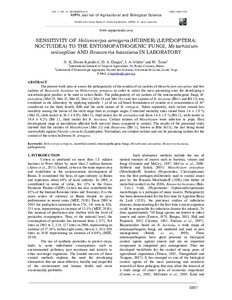| dc.contributor.author | Douro-Kpindou, O.K. |
| dc.contributor.author | Djegui, D.A. |
| dc.contributor.author | Glitho, I.A. |
| dc.contributor.author | Tamo, M. |
| dc.date.accessioned | 2019-12-04T11:08:24Z |
| dc.date.available | 2019-12-04T11:08:24Z |
| dc.date.issued | 2012-12 |
| dc.identifier.citation | Douro Kpindou, O., Djegui, D., Glitho, I.A. & Tamo, M. (2012). Sensitivity of Helicoverpa armigera (Hubner) (Lepidoptera: Noctuidea) to the Entomopathogenic fungi, Metarhizium anisopliae and Beauveria bassiana in laboratory. ARPN Journal of Agricultural and Biological Science, 7(12), 1007-1015. |
| dc.identifier.issn | 1990-6145 |
| dc.identifier.uri | https://hdl.handle.net/20.500.12478/1817 |
| dc.description.abstract | The present work aims to assess the pathogenicity of the conidia of six isolates of Metarhizium anisopliae and two isolates of Beauveria bassiana on Helicoverpa armigera in order to select the most promising ones for developing a microbiological product to be used in cotton fields. The pathogenicity of six isolates of the entomopathogenic fungi, M. anisopliae (Met 28, Met 32, Met 92, Met 31, Met 34 and Met 341) and two isolates of B. bassiana (Bb11 and Bb 12) was evaluated in the laboratory by applying topically 1 μl of an oil-based formulation of conidia at a concentration of 108 conidia/ml on the third, fourth, fifth and the sixth instars of H. armigera. Taken separately, each isolate caused less mortality among the larvae of the sixth stage than in younger stages. Corrected mortality rates varied from 3.6 ± 1.8 % (Met 28, sixth instar) to 56.3 ± 0.8% (Met 31, third instar) for M. anisopliae and from 3.6 ± 1.8 % (Bb 12, sixth instar) to 34.4 ± 4.2% (Bb 11, third instar) for B. bassiana. Certain isolates of Metarhizium were infective to pupa. Host development stage at inoculation affected both survival times compared to control. The results of the presented study showed that the isolates of Metarhizium (Met 31) and Beauveria (Bb 11, known as Bba 5653), the last being tested successfully against Plutella xylostella (Lepidoptera: Noctuidae), are virulent isolates and can be promising isolates for the control of the cotton bollworm H. armigera. |
| dc.format.extent | 1007-1015 |
| dc.language.iso | en |
| dc.subject | Helicoverpa Armigera |
| dc.subject | Microbial |
| dc.subject | Control |
| dc.subject | Entomopathogenic Fungi |
| dc.subject | Metarhizium Anisopliae |
| dc.subject | Beauveria Bassiana |
| dc.subject | Pathogenicity |
| dc.title | Sensitivity of Helicoverpa armigera (Hubner) (Lepidoptera: Noctuidea) to the Entomopathogenic fungi, Metarhizium anisopliae and Beauveria bassiana in laboratory. |
| dc.type | Journal Article |
| dc.description.version | Peer Review |
| cg.contributor.crp | Maize |
| cg.contributor.crp | Climate Change, Agriculture and Food Security |
| cg.contributor.affiliation | International Institute of Tropical Agriculture |
| cg.contributor.affiliation | Université de Lomé |
| cg.coverage.region | Africa |
| cg.coverage.region | West Africa |
| cg.coverage.country | Benin |
| cg.isijournal | ISI Journal |
| cg.authorship.types | CGIAR and developing country institute |
| cg.iitasubject | Pests Of Plants |
| cg.journal | ARPN Journal of Agricultural and Biological Science |
| cg.howpublished | Formally Published |
| cg.accessibilitystatus | Limited Access |
| local.dspaceid | 83269 |

